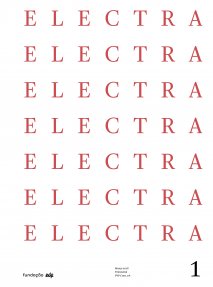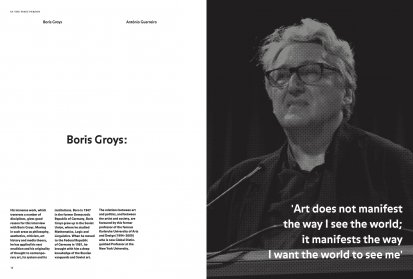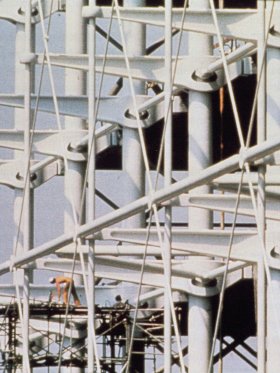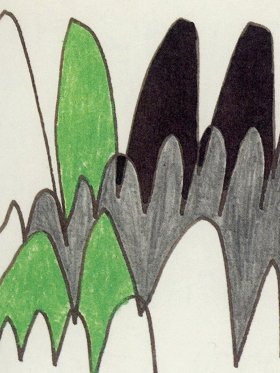His immense work, which traverses a number of disciplines, gives good reason for this interview with Boris Groys. Moving in such areas as philosophy, aesthetics, criticism, art history and media theory, he has applied his vast erudition and his originality of thought to contemporary art, its system and its institutions. Born in 1947 in the former Democratic Republic of Germany, Boris Groys grew up in the Soviet Union, where he studied Mathematics, Logic and Linguistics. When he moved to the Federal Republic of Germany in 1981, he brought with him a deep knowledge of the Russian vanguards and Soviet art. The relations between art and politics, and between the artist and society, are favoured by this former professor of the famous Karlsruhe University of Arts and Design (1994–2009) who is now Global Distinguished Professor at the New York University.

© Piero Mansoni
ANTÓNIO GUERREIRO You come from an enormous country, Russia, and you lived there under the Soviet regime until 1981, when you emigrated to the Federal Republic of Germany. How did you live and thought about that period, culturally and as a philosopher?
BORIS GROYS It was always clear to me that I had a chance to be a witness of a unique historical event, an exceptional social and political regime. It is a rare chance for a philosopher — and I was always grateful to the fate for this chance. In that time, the Stalinist regime was already over, but the Capitalism of the Western style was not there yet. So, the Soviet people lived in a kind of empty time, which was not so bad for somebody who tended to contemplation more than to action. The Western literature, philosophy and information about art were accessible if one was really interested in getting acquainted with them but publications or exhibitions in the West were impossible without the official consent. So, if one wanted to do something different from the officially established cultural norms one could read and speak, make art and write — but had to remain, so to say, below the radar, not to try to become known to the wider public.
AG However, you are completely apart from the kind of intellectuals that took that way. To us, your speech about communism and Stalinist culture is a new thing. What were the main preconceived ideas and clichés that you felt needed to be broken?
BG I would not say that in the West I was confronted with clichés or preconceived ideas about the Soviet Union. Rather, one completely ignored this country as a historical reality. One was for Communism or against Communism. But the Soviet Union was not an ideological abstraction, but rather a country populated by millions of very heterogeneous people living almost their whole life under an economic, political, and social system that was incomparable to any other system in the world. I tried to analyse the Soviet cultural production and the logic of its development. In the West, the Soviet culture was, as a rule, described only in terms of censorship. One wrote a lot about what was censored and why. But one was not so much interested in what was allowed, published, and exhibited. I tried to compensate this lack of interest and analysis.
AG Reading one of your works, The Total Art of Stalinism, we conclude there is a major misunderstanding of socialist realism and its aesthetic heritage, and that we must even revaluate modernism. What was it that the West never understood, and why?
BG Again, I would not say that something that was accessible to the Western public was not understood. But the Western public saw the art of the Russian avant-garde as well as the art of the socialist realism isolated from its social, economic, and political context. It is like when one sees the Egyptian mummies or Inca ritual objects in a museum: one can make an aesthetic judgment on them, but one does not quite understand what their original use was supposed to be. The Soviet art was not made to be aesthetically enjoyed. Rather, it was produced to create a new space of everyday life for the Soviet citizens. This space was a prefiguration of the coming Communist society — but also a means to build this society. The Soviet art cannot be understood when its active, utilitarian, life-building dimension is ignored. Today one speaks time and again about a possibility of art to shape life, to change the world. The Soviet art was a huge experiment in changing the world. Thus, it makes sense to look at its history from this point of view. And that is precisely what I tried to do.
AG You are both a philosopher and an art critic. However, in your work the boundaries between these two fields seem to have been abolished. What continuity do you find between Art and Philosophy? Is this question another way of putting the same question you are dealing with in a recent essay on art as the medium of truth?
BG I find that today there are only two fields for philosophical reflection: art and politics. Nature is described by the positive sciences. Culture is described by culture studies. However, art and politics cannot be made the object of scientific descriptions— because both of them react to these descriptions and try to escape them. Today, philosophy and art are two major ways in which the subject can manifest itself in the world. Our production, including also cultural production, functions mostly anonymously. But one signs a philosophical discourse and one signs an artwork and a poem or a novel. Earlier, one could say that philosophy was self-reflective and art purely expressive. But at least since Nietzsche, philosophy became expressive too — whereas during the period of modernism art became more and more analytical and self-reflective. Thus, today the boundaries between them became porous, indeed.
AG In your approach to art, what counts most is not the aesthetics, but the poetics. That is, art as production: production and thought about the world. In what way does art allow to think the world as you do?
BG I would say that art is primarily not about the world but about the subject who produces art. Art is a way in which the subject practices the design of its own appearance in the world. Art manifests not the way in which I see the world, but the way in which I want the world to see me. As a rule, we are unhappy with the image that we present to the world — so we try to change it by the means of philosophy, politics, and art. And by changing our image, we change the world itself. In this sense, I speak of the primacy of the poetic. Through its practice, art changes the world in which it takes place. Take architecture: we can like it or not — but we have to live inside it. Architecture defines our way of life — that can be said about all forms of design. But we are formed also by the movies that we see, the books that we read, etc. All that is not made by nature — and not made by us as readers or spectators. And our relationship to all this art is not an external, aesthetic relationship. We do not have the freedom of the aesthetic distance and aesthetic judgment. We are living inside art and are formed by it. So it is a legitimate question: how does this formative process take place? And it is precisely the question of poetics, and not aesthetics.
AG Does the idea of ‘global art’ go hand in hand with globalisation? Is the idea itself a consequence of globalisation? Or are the rules of art globalisation different from the logic of commodity globalisation?
BG First of all, the artworks are not commodities. Commodities are consumed, used — that means negated, destroyed. But artworks are protected, restored, and secured. They are not used — but only looked at. Of course, artworks can be sold and bought. The art commerce is, indeed, a part of the global commerce. But beyond their commercial value, the artworks have a symbolic value that has to do with their ability to be trans-cultural, universal. Contemporary art has its origin in the artistic avant-garde from the beginning of the 20th century. At that time, the avant-garde artists rejected their national traditions, broke with their cultural identities, and tried to create a new universalist, global culture. This project of universalisation and globalisation is still active, and cannot be reduced to the art market. In the art context there are many initiatives that have a political character — states, cities and regions want to present themselves, to give themselves an image. That is the source of all the Biennials, Documentas, Manifestas, etc. Of course, all these exhibition projects also cost money, but they are based on financing through patronage and not through the art market — even if public-private cooperation plays an important role here. In fact, today the international art scene is more universalist than any other part of the contemporary culture, because art is less dependent on the national languages. It is an actual reason for the global art circulation.
AG In a book of interviews, you talk about the ‘politics of immortality’ that art strives to achieve; on the other hand, you show that the condition of modern and contemporary art is fluidity. How can we solve this contradiction between art's desire for immortality and its liquid condition?
BG It is a problem, indeed. Initially, the art institutions, especially the art museums, promised a certain kind of secular immortality to the art works. The spiritual immortality of the soul was substituted by the material immortality of art. Our culture created a system of archives in which the art archives had a special role. All the other archives kept the memory of the past but the art museums did not merely inform about the art of the past — they presented this art to the gaze of the museum’s visitors. However, in our time the art museums began to be criticised for their selectivity. Beyond that, the public museums are financially too weak to compete with the private collectors on the global art market. That is why the Internet becomes more and more the new favoured place to present art to the wider public. The Internet seems to be non-selective, free from the power of curators, and truly global.
But this image of the Internet is misleading. After some years of its functioning, we can clearly see that the space of the Internet is not unified and universal but, rather, extremely fragmented. Of course, under its current regime all the Internet data is globally accessible. But in practice, the Internet leads not to the emergence of the universal public space but to the tribalisation of the public. The reason for that is very simple. The Internet reacts to the user’s questions — to the user’s clicks. In other words, the user finds on the Internet only what he or she wants to find there. The Internet is an extremely narcissistic medium — it is a mirror of our specific interests and desires. In the context of the Internet, we also communicate only with the people who share our interests and attitudes — be it political or aesthetic attitudes. Thus, the non-selective character of the Internet is an illusion. The factual functioning of the Internet is based on the non-explicit rules of selection according to which the users select only what they already know or are familiar with. Of course, some search programs are able to go through the whole Internet. But these programs have also always certain particular goals and are controlled by big corporations and not by individual users. For these individual users the Internet is the opposite of, let’s say, an urban space where we permanently have to see what we do not necessarily want to see. In many cases we try to ignore these unwanted images and impressions, in many cases they provoke our interest, but in any case it is how we expand our field of experience. The same can be said about the museum. The curatorial choices let us see what we would not choose to see, what is even unknown to us. Being, as I have already said, a public institution, the museum, if it is functioning properly, tries to transcend the fragmentation of the public space and create a universal space of representation that the Internet is incapable to create. The museum exhibitions are interesting and relevant when they select their contents from different fragments of the Internet and social networks.
And, beyond that, yes, the Internet is fluid — even if it offers possibilities to trace back the information and to secure it. The Internet is privately owned and driven by private interests that change in time. Of course, one can imagine the emergence of the Internet archives supported by the states that could stabilize the public memory — in an analogy to the state owned libraries and museums. But at the moment, it is only a fantasy.
AG What is a museum today, under the condition of contemporary art? To what extent is a contemporary art museum a paradoxical institution, or at least obliged to face new challenges?
BG The contemporary museum is basically a stage for organizing temporary curatorial projects, artistic installations, or artistic events. As such, it is important because it informs people about what is going on in contemporary art. And contemporary art is important because it is a public space in which one can formulate and express the positions, attitudes and desires that cannot be manifested in the mainstream media. But what is the main difference between a curatorial project and a traditional exhibition? The traditional exhibition treats its space as anonymous, a neutral one. Only the exhibited artworks are important — but not the space in which they are exhibited. Thus, artworks are perceived and treated as potentially immortal, even eternal — and the space of the exhibition as contingent, accidental. It is merely a station on which the immortal, self-identical artworks take a temporary rest on their wanderings through the material world. On the contrary, the installation — be it an artistic or curatorial installation — inscribes the exhibited artworks in this contingent material space. (Here one can see an analogy to the shift from Actor Theatre, or Actor Cinema towards the Director Theatre and Cinema). The curatorial project is the Gesamtkunstwerk because it instrumentalises all the exhibited artworks, makes them serve a common purpose that is formulated by the curator. At the same time, a curatorial or artistic installation is able to include all kinds of objects — some of them timebased artworks, or processes, some of them everyday objects, documentations, texts, etc. All these elements, as well as the architecture of the space, sound, or light loose their respective autonomy and begin to serve the creation of the whole in which visitors and spectators are also included. Thus, also the artworks of traditional type become temporalized, subjected to a certain scenario that changes their perception during the time of the installation — because this perception is dependent on the context of their presentation, and this context begins to flow. Thus, ultimately, every curatorial project demonstrates its accidental, contingent, eventful, finite character — its own precariousness.
AG You’ve said that ‘contemporary art is heir to the revolution’. Does art have a totalitarian temptation?
BG When I say that, I mean that contemporary art is the heir of the protest against the status quo. It is a difficult heritage because by being against the tradition, one necessarily fits into the tradition — precisely because our tradition is the tradition of protest. That means that for contemporary art to continue the artistic tradition, art has to deny it. But the denial of the tradition means its continuation. It is this paradox, inside which contemporary art moves.
AG Do historical vanguards reveal a deep relationship between art and politics? And today, when art has become increasingly democratic, how can this relationship be understood?
BG Has art become democratic? I am not sure about that. Art wants to be universalist but the artistic milieus exist and practice art inside the national cultures. Our understanding of democracy is intimately related to the concept of the national state. Such phenomenon as a universal democracy does not exist because the universal state does not exist. And so one can say that today’s art system plays the role of a symbolic substitution of such a universal state by organizing Biennials, Documentas, and other exhibitions having a claim to present the universal, global art and culture — that means art and culture of the non-existent, Utopian global state. That is why contemporary art is presented by the mainstream culture and media as being not democratic but, rather, elitist. Our time is characterized by a lack of balance between political and economic powers, between public institutions and commercial practices. Our economy operates on the global level, whereas our politics operate on the local level. Here the art system plays a crucial political role by, at least, partially compensating the lack of the global public space and global politics — but this role brings art in the opposition to the dominating national cultures.
AG Thinking about the ‘contemporary’ has become one of the most common tasks of our time. Why is our age so self-centred, as an object of thought? What does this reveal to us?
BG We are not very interested in the past — it seems too different from our own time. One has a feeling that our mode of existence is defined primarily by technology. And it is obvious that today’s technology is different form the technology that was used in the past. That creates an impression that the past has nothing to say to us because our conditions of existence are radically different. And we are not so much interested in the future because it seems to be too uncertain, too full of possible dangers. And, in general, we are enlightened enough not to look behind the horizon of our present existence, not to ignore the fact that we are mortal and our life is short. So, it is only natural that we are concentrated on our own time — and trying to understand it.
AG The museum, the archive, the Internet: how do you think the three co-relate?
BG The museum and the archives make selections that are explicit and can be criticized. They choose what seems relevant for art and history. But the Internet is simply a huge garbage can. One can find everything there that one expects to like — and nothing relevant at the same time.
AG In your book Going Public, you state that the Internet offers a combination of capitalist hardware and communist software. It is a conception as luminous and seductive as your definition of communism as a ‘linguistic turn’. Would you mind to elaborate briefly on the arguments you used to come up with these two definitions?
BG Well, the hardware of the Internet is privately owned — but the exchange of information on the Internet is basically for free. At least it was the case until now — nobody knows what will come next. Now, I speak about communism as a linguistic turn because, under the conditions of Communism/Socialism, one should always publicly explain the motives of one’s actions. One is not sovereign in a sense that one has an obligation of self-explanation. That is different from the Capitalist society, in which one is free to buy and sell as far as one has money to do so. Then, my decision to buy something is the only explanation. And there is a difference from the Fascist regimes that are based on the conviction that their leaders are somehow chosen by race or history. These leaders also do not need to explain their actions.
AG How did the relation between the producer and the spectator change? In one of your works, you portrait the artist as a masochist under the condition of mass culture. What happened to the celebrated modern concept of autonomy?
BG Oh, autonomy was always an ideological construction. Under the condition of the art market, an artist depends on the taste of the spectator/consumer. The artist can also try to become sovereign and to dictate this taste. But then the artist gets involved into politics, as the artists of the avant-garde did. Total autonomy is impossible, because artists produce art not for themselves but for others. Otherwise, art has no sense.
AG Besides being a philosopher and art critic, you are also presented as a ‘media theorist’. But your ‘mediology’ essays encompass a much larger field, which is very far from a conventional discipline. Would you like to comment?
BG I guess that people mean that I am a Medientheoretiker. The German term Medientheorie has no real translation into English. It means that the culture is analysed as a material process — rather than as a set of ideas. In other words, every communication, including literature and art, is analysed from the perspective of its material medium — and the specific use of this medium. In this sense, I am a Medientheoretiker indeed, because I was and still am interested in the material aspects of art and culture.





Share article